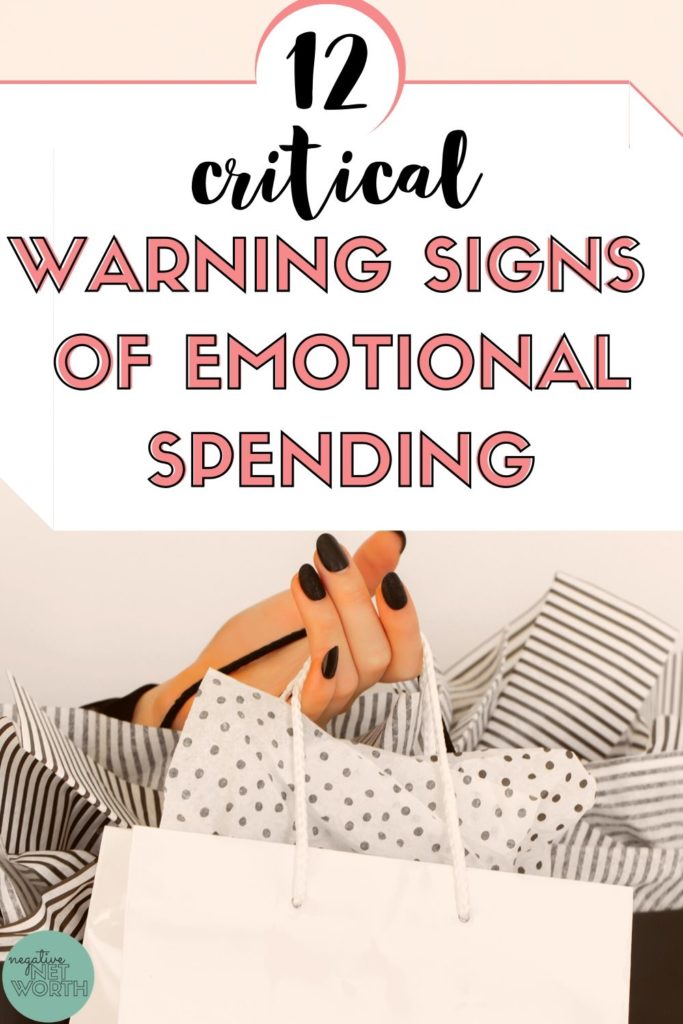
Emotional Spending
It happened again. You made a purchase—a big one, even—and you regret it.
You feel familiar sensations course through your body. Disgust, revulsion, anxiety…even panic.
How did I do this again? You wonder. I have a budget. I’m working on my finances. I thought I had my spending under control…
The culprit might be emotional spending.

Unsurprisingly, in an age where online retailers rule, and free two-day delivery is the norm, it has become easier than ever to assuage feelings of fear, sadness, anger, or inadequacy (just to name a few) by hopping over to YourFavoriteStore.com and loading your cart to the gills. But if you are trying to rein in your spending or pay down debt, it’s important to identify whether your spending is mindful, or emotional.
The Definition of Emotional Spending or Emotional Shopping
What is emotional spending anyway?
Emotional spending, or emotional shopping, is characterized by making purchases to improve your mood or make yourself feel better. It’s a temporary solution to a deeper problem, i.e., seeking a “hit” of dopamine through material goods instead of addressing your true feelings.
This type of spending is triggered by emotions, both negative and positive, and can quickly spiral into compulsive spending habits if unchecked.
One of the more surprising things about emotional spending is that it doesn’t look the same for everyone. In fact, some of your more “typical” spending habits might be more ruled by your feelings than you realize.
Now that we’ve got that out of the way, you might ask how to identify emotional spending or emotional shopping habits in your own life. What are the telltale signs of emotional shopping? And when should you be concerned?
The 12 Critical Warning Signs of Emotional Spending
By my estimation, there are 12 critical warning signs of emotional spending. Though they are all related in some way, and some may overlap, they independently can be a cause for concern if they’ve occurred more than once.
Here’s how this works. These warning signs are behaviors, and what underlies them is an emotion or set of emotions.
If you can identify the behavior, you might be able to identify the named emotion in your own life, so you can actually deal with that emotion—instead of shopping to escape from it.
So let’s get to it.
1. You shop when you are alone.
First on the list: you shop when you are by yourself. The reason this is a cause for concern is because your shopping is likely triggered by one (or both) of the following feelings: boredom and loneliness.
When you are feeling lonely or are simply looking to fill the time, do you find yourself scrolling over to YourFavoriteStore.com and clicking around? Even worse, do you find yourself filling up a cart and hitting “Checkout”?
If so, you might be engaging in emotional spending.
2. You shop in search of the new, the now, the next.
If you find yourself following trend-based social media accounts, or are glued to fashion magazines, there might be something deeper happening—especially if you are completing a purchase afterward.
Frequent attempts to reinvent yourself might not be driven by an innocent love of fashion or style, but instead an emotion: inadequacy.
The next time you find yourself shopping for trends, consider whether your emotions are to blame.
3. You shop to treat yo’ self.
Ah, Parks and Rec. A beloved sitcom, and source of one of the most repeated catchphrases in consumer culture:
Treat yo’ self.
If you find that you reward or celebrate your accomplishments by making purchases, you might be shopping emotionally. This could be a sign that you have not developed healthy ways to celebrate yourself outside of shopping—and are an emotional spender.
4. You often feel regret after shopping.
Do you feel remorse nearly every time you shop? For me, this was one of the tell-tale signs that I was shopping emotionally.
If you regret your purchases, it could mean you’re spending without thinking. Or, that you are so overcome with emotion, good or bad, that your thinking is utterly clouded.

5. You frequently return items after you buy them.
Along the lines of regretting purchases, if you frequently return items after you buy them, it could be a warning sign that you are engaging in emotional spending.
The reason? Your purchases are not well-thought-out, and are likely impulse-driven. You might be shopping for any number of emotional reasons, as opposed to logical ones.
6. You look for an instant reward or hit of happiness when you shop.
Do you seek instant gratification when you spend? If so, you may be an emotional shopper.
By seeking fulfillment through material goods, you might be engaging in unhealthy coping strategies, and using shopping as a tool to deal with underlying issues.
7. You shop to keep up with your friends, colleagues, or family.
Keeping Up With the Joneses. It’s a dated reference, but it applies today all the same. If you find yourself shopping to keep up with the people around you, it could be a sign that you’re an emotional spender.
Why is that? Well, it’s actually driven by two emotions: jealousy and inadequacy. If you feel like you can’t measure up unless you buy something, or you don’t feel good enough without buying something, that, my friend, is an emotional shopper.
8. You shop because you’re afraid of a sale ending or an item selling out.
Do you recognize this behavior? Because I sure do.
It’s something I hate to admit, but one of my biggest spending triggers before I cleaned up my act was limited edition items, like makeup. Even worse were limited-time, once-per-year blowout sales.
Here’s why this is a warning sign you are an emotional spender: this type of shopping is driven by fear.
9. You shop because you’re already in financial distress.
If you find yourself shopping because your debt is already so bad you can hardly confront it, or because you’re too overwhelmed by your financial health (or lack thereof), this could be a sign that you are an emotional spender.
The reason for this is you are shopping in this scenario to avoid uncomfortable feelings associated with a difficult life problem. You don’t need me to tell you that your time (and finances) would be better served if you dealt with those feelings head-on instead of drowning them in more stuff.
10. You shop, and then you hide your purchases.
Are you hiding purchases from a spouse or other family member? Do you have bags sitting in the trunk of your car, or packages squirreled away in the back of your closet?
If so, you might be engaging in emotional spending. Although it may seem obvious, when you feel guilt over a purchase, there is a strong likelihood you should not have made it in the first place—and that you bought it for reasons other than rational, mindful ones.
11. You shop out of obligation to others.
Here is one you may not have recognized as emotional shopping before this article: spending out of a sense of obligation.
One way this shows up is when you buy gifts for other people (like a boss, for instance), not because you care for them or want to celebrate them, but rather out of feelings of guilt.
This is kind of the inverse of our last warning sign. When you hide purchases, you do so because the act of shopping made you feel guilty. But when you shop out of obligation, you are shopping because you feel guilty.
12. You shop to engage in “retail therapy.”
Last, but certainly not least, the biggest warning sign of all: you engage in retail therapy.
In other words, you shop when you are sad, stressed, or overwhelmed. You might even shop when you are hungry, angry, or tired.
This most basic of warning signs is also the most common sign, which tells you that you are using emotional spending habits to avoid coping with your real feelings. You are, quite simply, using shopping as a means to numb yourself from that which hurts.

Gaining Better Spending Habits
So what are you to do now that you’ve identified emotional spending habits in your own life? How do you stop spending emotionally?
Free Resource Library
My first suggestion is to head on over to the free Resource Library and take a spin through the printable worksheets and checklists to help you stop spending and start saving. If you need the password to the Resource Library, click here.
Articles on How to Stop Shopping
Here are some follow-up articles that will help you stop shopping:
- How to Rock Your No Buy
- 10 Things To Do Instead of Shopping
- How to Love What You Already Have—So You Can Stop Shopping
- How To Shop Mindfully (and Save Money)
- How To Stop Shopping After You’ve Filled Up a Cart
- 7 Approachable Minimalism Strategies to Stop Shopping
These posts have all sorts of tips and tricks to help with your emotional spending habits, and to help you stop making unnecessary purchases generally.
The Best Workbook to Stop Shopping
Finally, if you want a free, printable workbook to help you work through your shopping habits, look no further:
This workbook will walk you, step-by-step, through the process of determining whether you need a No Buy, No Spend, or Spending Freeze; why you might need a No Buy; and how to complete a No Buy successfully.
Conclusion
Listen, I get it. Life can be difficult and unrelenting. It can be easy at times to feel like the only tool in your coping toolbox is shopping or “retail therapy.”
But it doesn’t have to be that way. By identifying these warning signs of emotional spending, and pausing the next time you recognize this behavior in your own life, you are well on your way to fixing your poor spending habits—for good.
Have you identified any of these behaviors in your own life? Can you think of any others? Let me know in the comments.



Leave a Reply